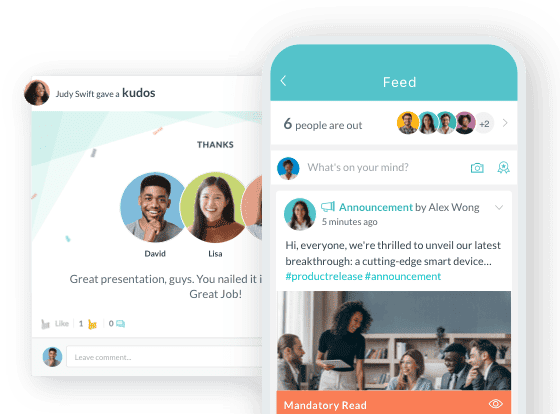Remote Employee Recognition: The Complete 2025 Playbook
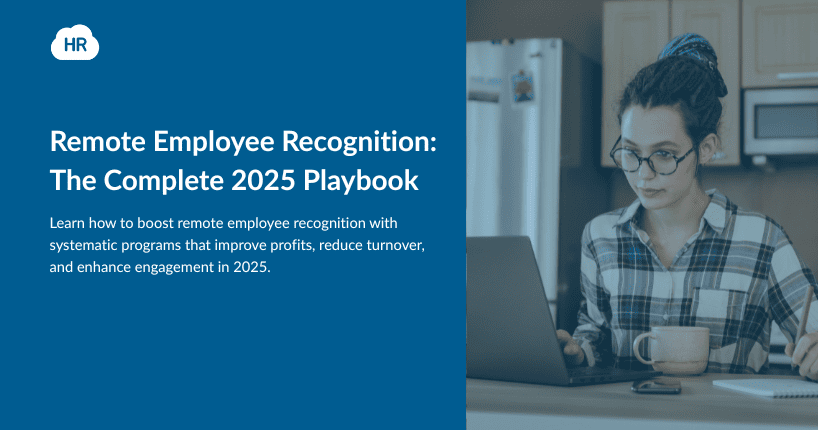
- Introduction: The $1.9 Trillion Recognition Gap
- The State of Remote Recognition in 2025
- Why Remote Recognition Is Fundamentally Different
- The 7 Pillars of Effective Remote Recognition
- Platform Comparison: What Actually Works
- Getting Started: Your 30-Day Action Plan
- Remote Recognition Ideas That Work
- Overcoming Common Challenges
- The Future of Remote Recognition
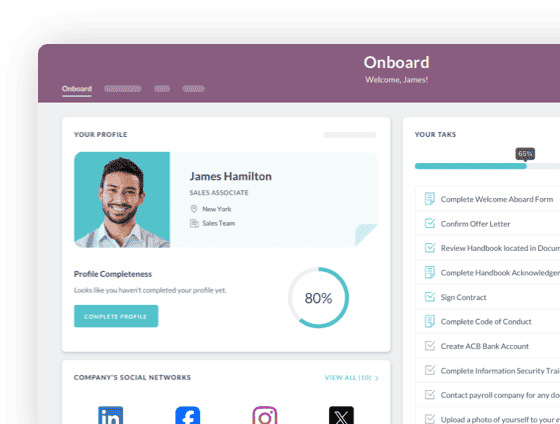
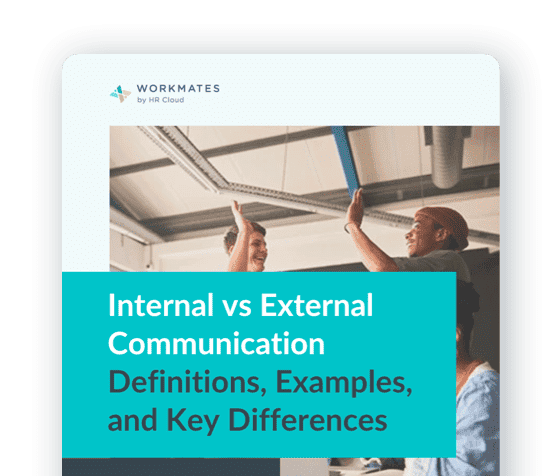
 Cut onboarding time
by 60%—here's the
Ultimate Checklist
that helped do it.
Cut onboarding time
by 60%—here's the
Ultimate Checklist
that helped do it.
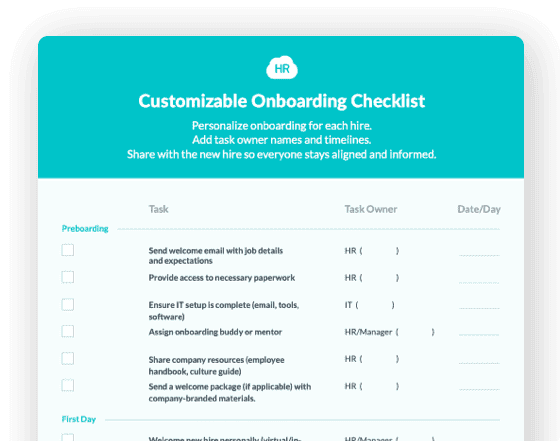
Remote employee recognition separates thriving companies from struggling ones in 2025. With 82% of remote workers feeling unrecognized, organizations face a retention crisis costing billions annually. This playbook reveals how systematic recognition programs deliver measurable results: 21% higher profits, 18% lower turnover, and employees 9x more likely to feel belonging when recognized weekly. Learn what separates effective employee recognition software from ineffective solutions, discover why comprehensive employee engagement platforms outperform standalone recognition tools, and get your 30-day implementation roadmap for building a culture of appreciation in distributed teams.
Introduction: The $1.9 Trillion Recognition Gap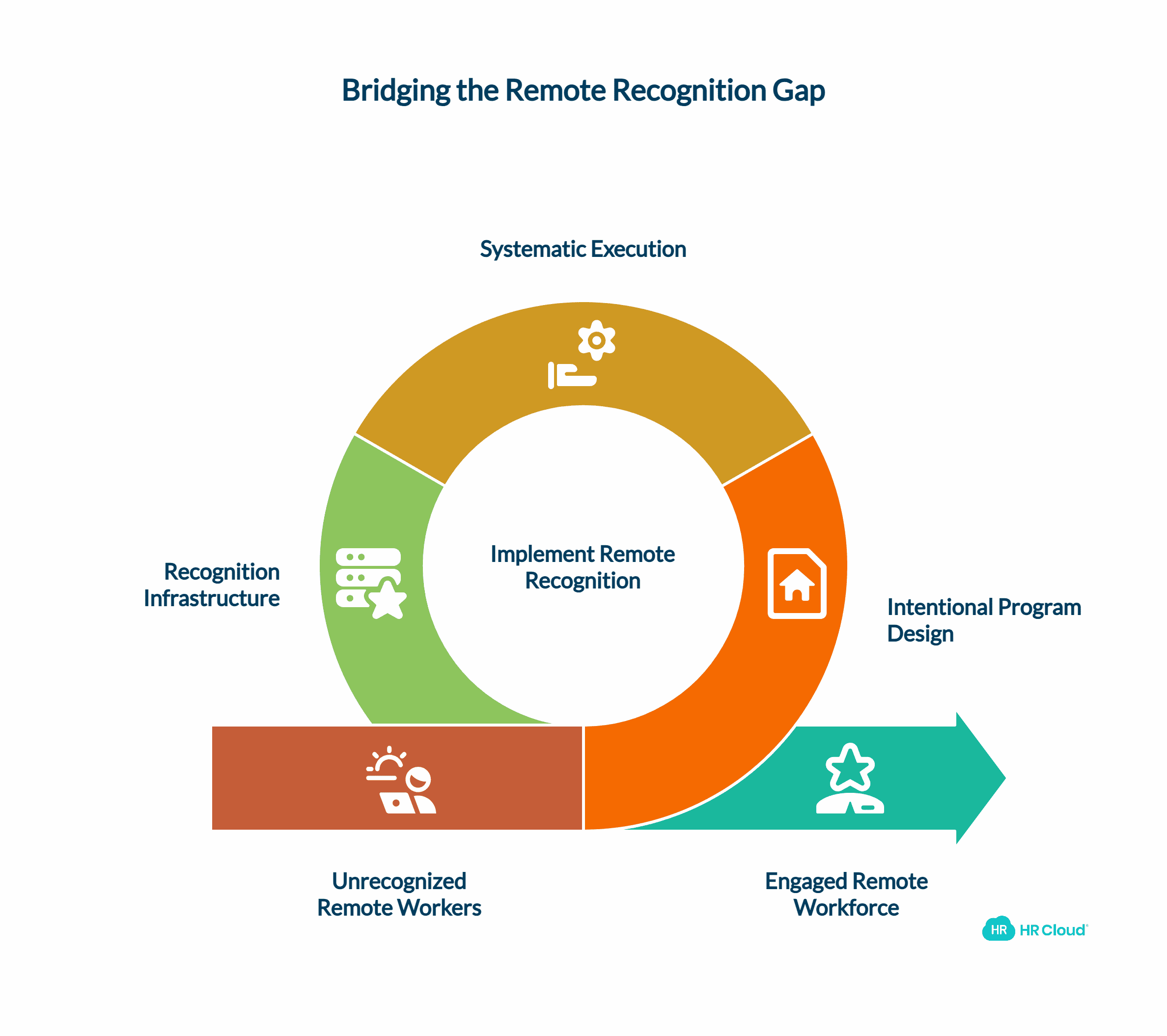
Your top performer just resigned. Exit interview reveals they felt invisible, unappreciated, and forgotten despite delivering exceptional results quarter after quarter from their home office. This scenario repeats thousands of times daily across remote workforces struggling with employee appreciation programs.
82% of remote workers feel unrecognized by employers, creating resignation letters waiting to be written. Remote work didn't just change where we work—it fundamentally altered how workplace recognition happens and how organizations maintain employee morale across virtual teams.
The cost? Disengaged employees drain approximately $1.9 trillion in U.S. productivity. 66% say they'd leave without appreciation, costing organizations 50-200% of annual salary to replace each departing team member through recruiting costs, training expenses, and lost productivity.
Traditional recognition methods—birthday cakes, spontaneous desk visits, hallway high-fives—disappeared with empty offices. What companies missed: recognition doesn't automatically translate virtually. It requires intentional program design, systematic execution, and recognition infrastructure purpose-built for distributed teams and hybrid workforces.
This playbook delivers actionable solutions for HR leaders and people managers. You'll discover why remote recognition differs fundamentally from office-based employee appreciation, learn which employee recognition platforms actually drive results and boost employee satisfaction, and get a 30-day action plan transforming how your organization values people regardless of location or work arrangement.
Key Takeaways
Recognition frequency drives employee retention and workforce stability. Employees recognized weekly are 9x more likely to feel belonging compared to monthly acknowledgment, making consistent appreciation critical for reducing turnover rates in remote work environments.
Peer recognition delivers superior ROI and business outcomes. Peer-to-peer appreciation generates 35.7% better financial results than manager-only recognition, demonstrating why employee recognition programs should empower team members to acknowledge each other's contributions.
Business impact is measurable through key performance indicators. Strong recognition programs achieve 21% higher profits and 18% lower turnover, proving that investing in recognition software and appreciation strategies directly impacts organizational success and employee experience.
Platform integration determines program adoption success. Recognition tools embedded in daily workflows see 3-5x higher participation than standalone systems requiring separate logins, making software selection and integration capabilities critical factors when choosing employee engagement solutions.
Comprehensive platforms beat piecemeal approaches for virtual teams. Organizations using unified employee experience platforms report better adoption rates and stronger cultural impact than companies cobbling together multiple point solutions for recognition and rewards management.
Automation ensures consistency across distributed workforces. Platforms with automated milestone recognition and manager prompts prevent recognition gaps that lead to turnover by ensuring work anniversaries, birthdays, and achievements never go unacknowledged in remote settings.
Analytics drive equity in recognition distribution. Real-time dashboards identifying recognition patterns and distribution gaps enable proactive intervention before equity issues damage workplace culture and employee morale in hybrid work arrangements.
The State of Remote Recognition in 2025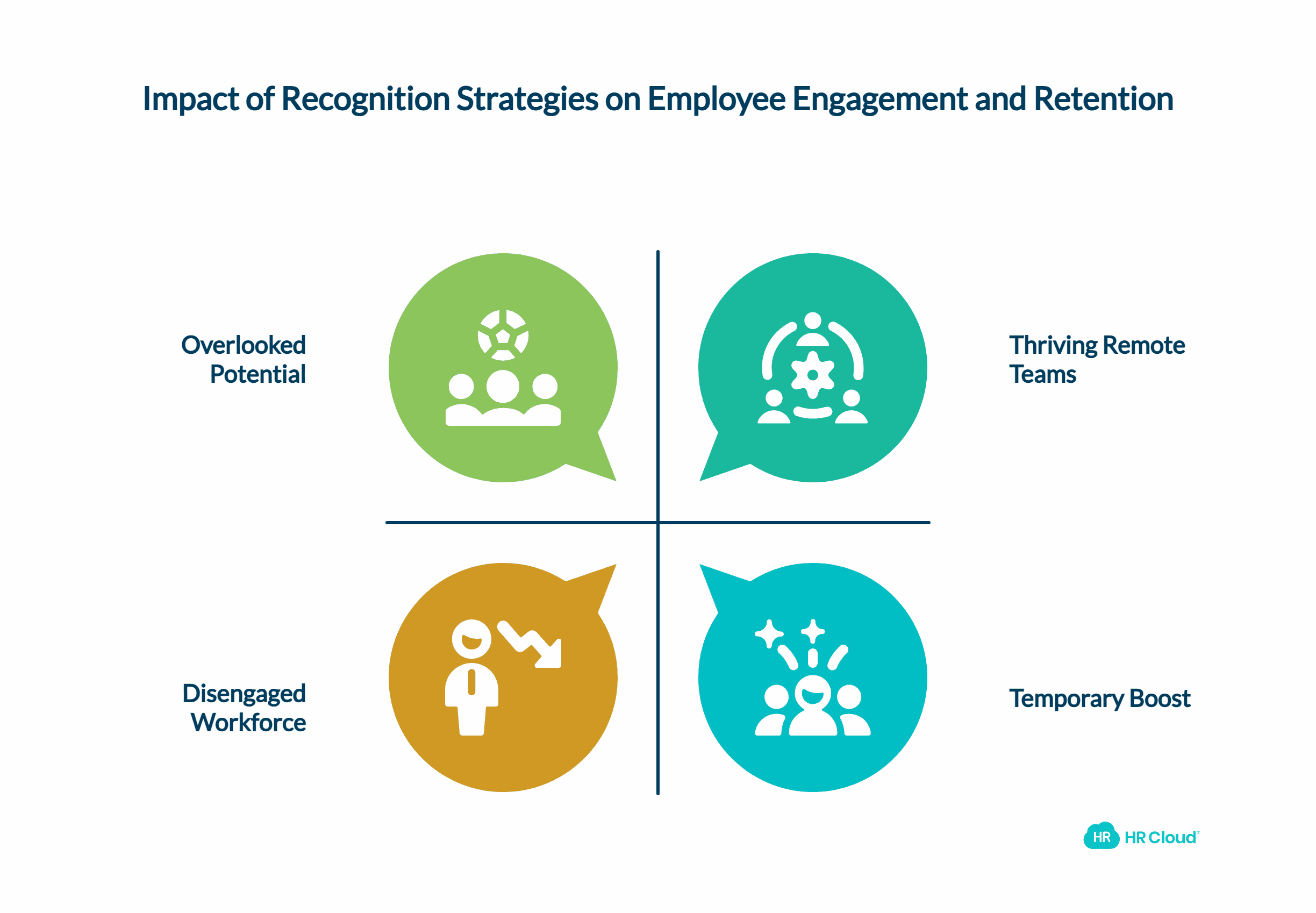
Remote work isn't temporary—it's the standard operating model for modern businesses. 75% of employees with remote-capable jobs work from home at least part-time. Organizations that haven't adapted their employee recognition strategies and staff appreciation programs face serious engagement challenges and retention problems across their distributed teams.
The Recognition Gap Widening Fast
The data tells a stark story about employee engagement and workplace satisfaction. While 85% of companies with recognition programs report positive engagement impacts, most remote employees still feel overlooked in daily operations. 65% haven't been recognized in the past year, creating what workforce experts call a "recognition deficit" that damages company culture and employee loyalty.
This matters for business performance and talent retention because 69% would work harder if better appreciated. That's not a marginal improvement—it's a wholesale shift in discretionary effort directly impacting bottom-line results and organizational productivity. Even more compelling: organizations with recognition programs see 1,181% increase in great work across their workforce.
Why Traditional Recognition Fails Remotely
Office-centric recognition depended on physical proximity and spontaneous interactions. Managers saw who stayed late, who helped colleagues troubleshoot problems, who delivered exceptional work quality. Spontaneous recognition happened naturally through quick praise at desks, celebration lunches for team wins, and visible acknowledgment in meetings where everyone was present in the same room.
Remote work shattered these informal recognition channels and appreciation opportunities. Managers can't see daily contributions from scattered home offices across continents and time zones. Spontaneous appreciation doesn't happen in scheduled video calls or virtual meetings. Timing delays compound problems—by the time managers learn about accomplishments through status reports or project updates, the recognition moment has passed, and the psychological impact diminishes significantly.
Visibility creates equity issues in hybrid and fully remote teams. In-office employees naturally get more leadership face time and attention. They're more likely to be seen, remembered, and acknowledged for their contributions. Remote workers—especially those in different time zones or working non-traditional hours—become invisible in organizational awareness. Their excellent work happens in the dark, unnoticed and unappreciated, despite equal or superior performance levels.
Discover how systematic recognition infrastructure solves visibility and equity challenges through automation features, analytics dashboards, and seamless integration into existing communication workflows and collaboration tools.
The Financial Impact of Recognition Failures
Turnover costs organizations 50-200% of individual salaries when accounting for recruiting expenses, training investments, lost productivity during vacancy periods, and knowledge drain affecting team performance. For a mid-level employee earning $60,000 annually, replacement costs range from $30,000 to $120,000 depending on role complexity and organizational structure. Companies with low engagement see 18-43% higher turnover compared to highly engaged organizations with strong appreciation cultures.
Beyond turnover costs, disengagement creates a productivity tax across operations. Employees who don't feel valued do the minimum required work, nothing more. Innovation dies, collaboration suffers, customer experience degrades, and organizational agility decreases. In competitive talent markets and tight labor conditions, organizations known for poor recognition and low engagement struggle to attract top talent and skilled professionals. Word spreads quickly on employer review sites, social media platforms, and professional networks, turning recognition deficit into recruiting liability that compounds over time.
Why Remote Recognition is Fundamentally Different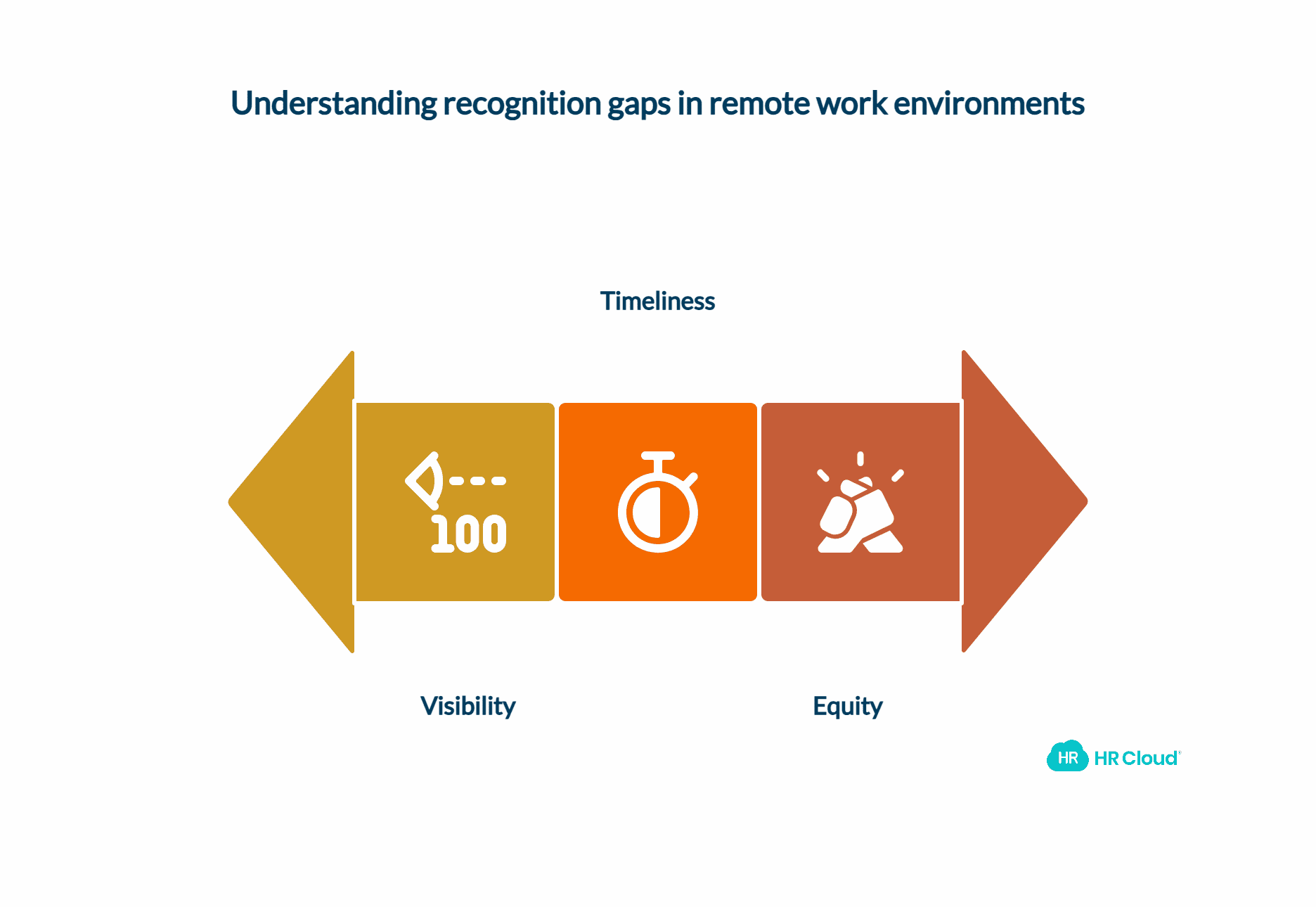
Remote recognition isn't just in-office appreciation over video calls. It's entirely different, requiring new thinking, new systems, and new behaviors.
Psychological Distance Creates Real Problems
"Out of sight, out of mind" isn't cliché—it's documented psychology affecting remote teams. When managers can't physically see employees working, cognitive biases kick in. Recency bias means they remember people they've interacted with most recently. Proximity bias leads them to overvalue contributions from nearby colleagues while undervaluing distant ones.
This creates "visibility bias" in hybrid environments. Research shows remote workers face unique challenges including isolation, lack of recognition, and disconnection. Employees working from home three days weekly receive less recognition than those in-office five days, even with identical performance.
Asynchronous work patterns exacerbate challenges. In global teams spanning multiple time zones, someone delivering exceptional work at 2 AM Pacific might not get noticed until the next day, when the moment has passed and attention shifted elsewhere.
The Three Critical Recognition Gaps
The Visibility Gap emerges when managers can't see work happening. In offices, they observe employees helping colleagues, solving problems on the fly, and going above and beyond. Remote work hides these contributions. Unless someone explicitly communicates achievements, managers remain unaware. This particularly affects introverted team members who don't naturally self-promote.
The Timeliness Gap occurs when recognition gets delayed. Research shows the closer recognition is to the action, the more effective it becomes. But remote work introduces friction. Managers learn about accomplishments through delayed channels—status reports, weekly check-ins, second-hand information. By the time they offer recognition, psychological impact has diminished significantly.
The Equity Gap manifests as systematic differences in recognition between in-office and remote employees, headquarters versus satellite workers, and employees in leadership's time zone versus those working different hours. Without intentional systems ensuring equitable recognition, patterns emerge where certain employees receive disproportionate acknowledgment while others are systematically overlooked.
What Remote Employees Actually Need
Remote workers don't want participation trophies. They need frequent, specific acknowledgment that contributions matter and connect to organizational success. Generic "great job" messages feel patronizing. Specific recognition naming behavior, describing impact, and connecting to values resonates deeply.
They need both public and private recognition options. Some thrive on public acknowledgment in team channels and company-wide feeds. Others prefer quieter, one-on-one appreciation. Effective systems accommodate both preferences, allowing employees to indicate how they want recognition.
Peer-driven appreciation matters enormously. Colleagues often have better visibility into day-to-day contributions than managers. Creating a culture where peers regularly acknowledge each other builds stronger team bonds and distributes recognition more equitably than manager-only approaches.
Tangible rewards working across geographies demonstrate genuine appreciation. A U.S.-only gift card doesn't help your engineer in Portugal. Effective programs offer global options—digital gift cards, charitable donations, professional development credits, experiences—resonating with diverse teams.
Most importantly, recognition must integrate into existing communication flows. Platforms requiring separate logins, special apps, or extra steps create friction, killing participation. Best recognition happens where work already occurs—in Slack, Teams, email, and tools teams use daily.
The 7 Pillars of Effective Remote Recognition
Building recognition programs that actually work requires systematic attention to seven core pillars. Organizations excelling at remote recognition consistently execute across all seven.
Pillar 1: Make It Frequent and Immediate
Timing is everything. Employees receiving meaningful recognition at least weekly are 9x more likely to feel strong belonging compared to those recognized monthly. Weekly recognition establishes reinforcement schedules that shape behavior more effectively than sporadic acknowledgment.
Automation solves the remembering problem. Birthdays, work anniversaries, project completions, and onboarding milestones should trigger automatic recognition without manual tracking. Modern employee engagement platforms enable automated milestone celebrations, ensuring no achievement goes unnoticed.
Real-time feeds and push notifications create immediacy. When recognition happens, relevant team members should see it immediately through channels they already monitor. The goal is shortening the gap between accomplishment and acknowledgment to hours, not days or weeks.
Pillar 2: Empower Peer-to-Peer Recognition
Manager recognition matters, but peer recognition drives results. Data shows peer-to-peer recognition is 35.7% more likely to have positive financial impacts than manager-only recognition. Peers have better visibility into daily contributions, provide more specific feedback, and create a mutual appreciation culture, strengthening team bonds.
Manager-only recognition creates bottlenecks. Managers can't see everything, especially remotely. They might manage 8-12+ people, making it impossible to observe every contribution worth acknowledging. Peer recognition distributes this responsibility, dramatically increasing recognition frequency and coverage.
Digital kudos systems, badges, and points make peer appreciation easy and visible. The key is removing friction. Platforms supporting seamless peer recognition through existing communication tools see significantly higher participation than standalone systems.
Pillar 3: Align Recognition With Company Values
Values-based recognition transforms abstract statements into tangible behaviors. When recognition explicitly connects to company values, it clarifies what those values mean in practice and reinforces behaviors the organization wants to cultivate.
Compare "Great job on the project" with "Your collaborative approach exemplified our teamwork value—you proactively included stakeholders from three departments, built consensus despite conflicting priorities, and ensured everyone felt heard." The second version makes values concrete and teachable.
Recognition platforms allowing customizable categories tied to company values enable organizations to reinforce a unique culture. Tech companies might have categories for innovation, customer obsession, and bias for action. Healthcare organizations might emphasize compassion, safety, and continuous improvement.
Pillar 4: Offer Meaningful, Flexible Rewards
Recognition without rewards feels incomplete. While social recognition carries psychological weight, tangible rewards demonstrate that appreciation translates into something concrete. The challenge in distributed workforces is creating programs that work across diverse geographies, cultures, and preferences.
One-size-fits-all programs fail. A restaurant gift card with no local locations provides zero value. A reward violating cultural or religious preferences creates discomfort. Generic company swag might delight one person and collect dust in another's closet.
Recognition platforms offering 100+ gift card options, customizable rewards storefronts, and flexible redemption enable personalization at scale. Employees accumulate points or credits and select rewards genuinely mattering to them—whether coffee gift cards, professional development courses, charitable contributions, or extra time off.
Pillar 5: Create Visibility and Transparency
Recognition hidden from view provides limited value. Psychological and cultural benefits multiply when appreciation is visible to relevant stakeholders—teammates, leadership, cross-functional partners, sometimes the entire organization.
Public recognition feeds serve multiple purposes. They showcase what the organization values, celebrate contributions that might otherwise go unnoticed, and create positive social proof encouraging more recognition. When employees see appreciation flowing regularly, they're more likely to both give and expect recognition themselves.
Leadership visibility into recognition patterns enables data-driven management. Analytics showing recognition distribution help identify problems—departments or individuals receiving disproportionately little acknowledgment, managers who rarely recognize teams, equity gaps between remote and in-office employees. These analytics shouldn't become surveillance but should ensure recognition flows equitably.
Pillar 6: Make It Easy and Integrated
The biggest adoption barrier isn't lack of goodwill—it's friction. Even well-intentioned managers won't consistently recognize if the process is complicated, time-consuming, or requires context switching between tools.
Platform adoption challenges plague enterprise software. Organizations implement recognition tools requiring separate logins, special training, complex interfaces, and workflows not match how people actually work. Adoption rates languish at 20-30%, rendering investments wasteful and cultural impact minimal.
Meeting employees where they work eliminates friction. Recognition platforms integrating natively with Slack, Microsoft Teams, and email enable appreciation without leaving primary communication channels. Managers can send kudos directly from Slack using simple commands. Employees receive recognition notifications in tools they already monitor multiple times daily.
Mobile accessibility is non-negotiable for deskless workers. Retail employees, healthcare workers, manufacturing teams, field service technicians, and hospitality staff need mobile-first recognition access. If platforms only work well on desktops, they exclude significant portions.
Pillar 7: Measure and Optimize
What gets measured gets managed. Recognition programs without measurement run on hope rather than data, making it impossible to prove impact, optimize effectiveness, or secure continued investment.
Recognition KPIs should track multiple dimensions. Participation rates reveal adoption—what percentage of employees give recognition, what percentage receive it, and how frequently recognition occurs. Engagement scores from pulse surveys can correlate with recognition frequency, testing whether acknowledged employees show higher engagement.
Retention rates provide the ultimate measure. Organizations should track whether employees receiving regular recognition exhibit lower turnover than those who don't, whether specific recognition types correlate with retention differently, and whether recognition trends predict flight risk.
Analytics dashboards providing real-time insights enable proactive management. Leaders can identify recognition deserts—teams where appreciation rarely happens. They can spot equity gaps—disparities between remote and in-office recognition, or between demographic groups. They can evaluate whether manager training on recognition drove behavioral change.
Transform recognition from a well-intentioned activity to a systematic cultural advantage. Explore how comprehensive platforms address these challenges through integrated technology, actionable analytics, and equity-focused design.
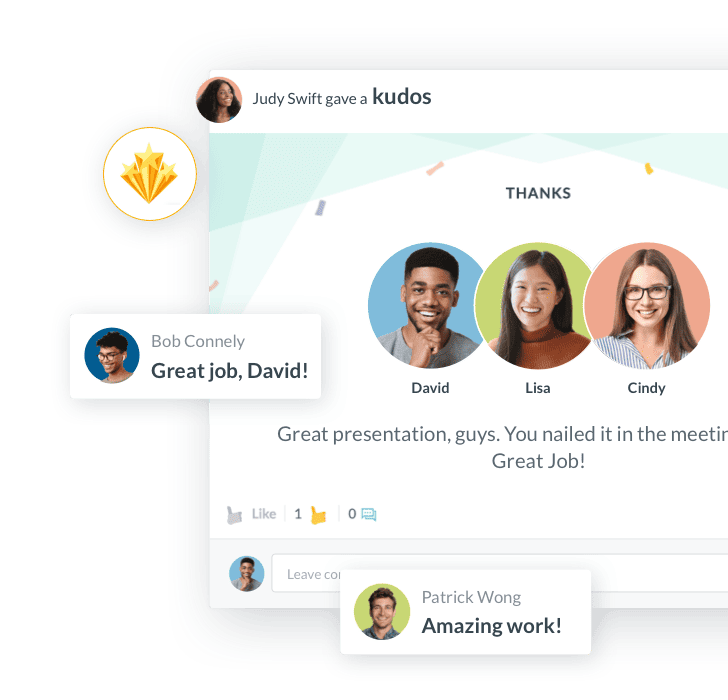
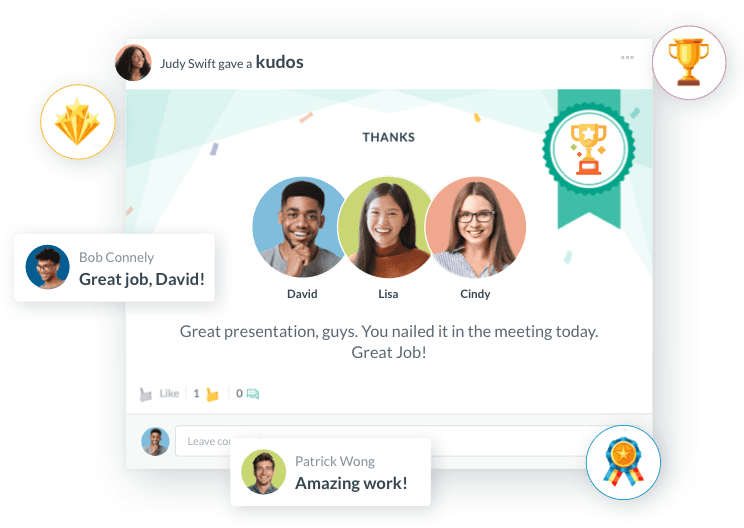
Platform Comparison: What Actually Works
Recognition Platform Ratings & Capabilities
HR Cloud Workmates earns strong marks for comprehensive employee experience. With a 4.6/5 rating on Capterra based on verified reviews, users consistently praise its ease of use and quick adoption. The platform excels in several critical areas where competitors struggle.
The all-in-one approach integrates recognition with communication, onboarding, and culture-building—eliminating the fragmented tool landscape that kills adoption. Native Slack and Teams integration means recognition happens in workflow, not outside it. The platform supports 100+ gift card options with global accessibility, automated milestone recognition, and real-time analytics dashboards identifying equity gaps.
Implementation typically takes 3-4 weeks versus 8-12 weeks for competitors, with customers highlighting "A+ support" and responsive customer success teams in reviews. The modular pricing approach allows organizations to start with core features and scale, making it cost-effective for growing companies.
Key Differentiators: Mobile-first design for deskless workers, customizable recognition categories aligned to company values, peer-to-peer kudos integrated with rewards catalog, and SSO eliminating login friction.
Where Competitors Fall Short
Lattice treats recognition as a secondary feature rather than a core capability. Users report several significant weaknesses in reviews across G2, Capterra, and independent sites. The platform focuses primarily on performance management, with recognition feeling bolted on rather than integrated.
Common complaints include expensive pricing with $4,000+ annual minimums prohibitive for smaller organizations, complex navigation requiring extra clicks to access features, messy reporting needing significant cleanup before usability, and limited customization options restricting how recognition aligns with unique cultures.
Several reviewers note "recognition features may not be as comprehensive or easy to use" compared to specialized platforms. The system lacks sophisticated peer recognition mechanisms, offers limited reward flexibility, and doesn't provide the social, values-driven recognition experience building genuine cultural connection.
Lattice struggles with: Recognition as afterthought not core function, rigid interfaces requiring heavy training, weak mobile experiences excluding deskless workers, and analytics described as "clunky" requiring manual data cleanup.
BambooHR excels at core HR functions but recognition isn't among them. The platform serves small to mid-sized businesses well for HRIS needs, but companies seeking robust recognition capabilities find significant gaps.
Recognition and rewards functionality requires add-ons rather than being native features, creating additional costs and integration complexity. Multiple reviewers mention "doesn't link well with other platforms" and integration challenges creating workflow friction. The system lacks peer-to-peer recognition infrastructure, offers limited reward options, and doesn't provide the engagement features driving cultural transformation.
Cost concerns emerge frequently in reviews. While BambooHR delivers value for basic HR management, companies report costs escalating quickly when adding features needed for effective recognition. The per-employee pricing model combined with add-on fees makes it expensive for organizations prioritizing recognition and engagement.
BambooHR weaknesses: Recognition requires separate add-ons, poor integration with communication tools, limited peer recognition capabilities, escalating costs with feature additions, and support described as "hit or miss" for implementation issues.
Why Comprehensive Platforms Win
Organizations comparing recognition solutions face a fundamental choice: standalone recognition tools or comprehensive employee experience platforms. The data increasingly favors comprehensive approaches.
Standalone tools require separate logins, create data silos disconnected from other HR systems, add to platform fatigue that kills adoption, and lack context from broader employee journeys. Recognition doesn't exist in isolation—it connects to communication, onboarding, development, and retention strategies.
Comprehensive platforms like HR Cloud Workmates unite recognition with internal communication, social feeds, surveys, and analytics in unified experiences. This integration drives compounding value exceeding standalone tools. Employees access everything through one platform, data flows between systems enabling sophisticated analytics, and administration burden decreases dramatically.
Companies report that unified platforms see 3-5x higher adoption rates than standalone recognition tools because friction disappears. The same login, same interface, same mobile app serves multiple purposes, making daily use natural rather than requiring special trips to dedicated recognition platforms that become isolated islands.
Getting Started: Your 30-Day Action Plan
Days 1-10: Assess and Strategize
Start by measuring current state. Anonymous employee surveys provide honest assessment of recognition effectiveness. Ask how frequently employees receive recognition, whether acknowledgment is distributed fairly, what recognition types resonate most, and what barriers prevent more appreciation.
Analyze existing recognition patterns using available data. If using any recognition tools currently, pull participation metrics. Review manager one-on-one notes for recognition mentions. Examine employee engagement survey results for recognition-related questions. Document pain points preventing consistent appreciation.
Define success metrics guiding program design. Establish baseline measurements for employee engagement, turnover rates, recognition frequency, and participation. Set ambitious but achievable targets for 6-12 month improvement.
Secure leadership buy-in through compelling business case presentations. Use industry data showing recognition ROI, present employee survey results revealing current gaps, calculate turnover costs recognition could prevent, and propose reasonable budget allocations based on per-employee costs.
Days 11-20: Infrastructure Selection and Design
Evaluate recognition platforms through demos, trials, and reference calls. Request demonstrations from comprehensive employee engagement platforms and standalone tools, comparing integration capabilities, mobile experiences, customization options, and analytics features.
Map integration requirements with existing tools. List all systems recognition platforms must connect with—HRIS, payroll, Slack, Teams, email, SSO—and verify platforms under consideration support necessary integrations.
Design recognition workflows defining how appreciation flows. Document peer recognition processes, manager acknowledgment expectations, formal award procedures, and milestone celebration workflows. Create recognition templates and suggested language reducing friction and maintaining quality.
Establish reward structure determining investment per employee annually, how rewards distribute across recognition types, and what approval workflows govern different recognition levels.
Days 21-30: Launch and Activate
Soft launch with pilot group tests the program with early adopters before company-wide rollout. Select enthusiastic managers and engaged employees to pilot the program, provide feedback, identify friction points, and generate testimonials.
Train managers and recognition champions ensuring those driving adoption understand program mechanics, business case, and best practices. Conduct interactive sessions teaching recognition frameworks, demonstrating platform functionality, and role-playing effective appreciation scenarios.
Company-wide announcement launches officially with excitement and clarity. Send all-hands emails explaining program purpose, benefits, and mechanics. Host virtual launch events demonstrating platform use. Create FAQ documents addressing common questions.
Monitor participation and gather initial feedback tracking early adoption rates, identifying barriers preventing participation, collecting user feedback about platform usability, and celebrating early successes building momentum.
Start your recognition transformation today. Schedule a personalized consultation to explore how comprehensive platforms accelerate your journey from recognition gaps to thriving appreciation culture.
Remote Recognition Ideas That Work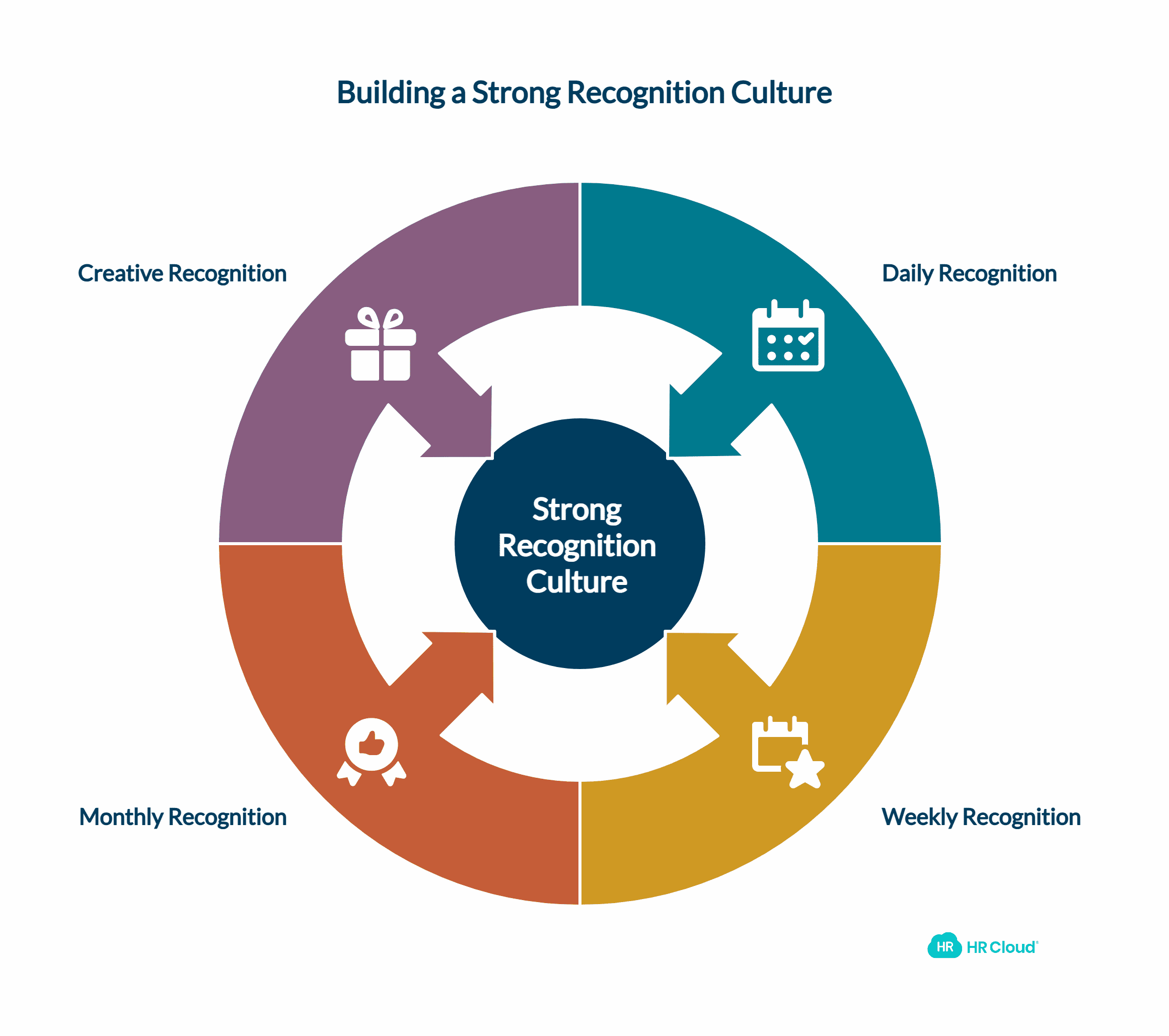
Daily recognition builds appreciation culture foundation. Kudos in team channels for small wins make daily contributions visible, taking seconds but delivering meaningful impact. Recognition during virtual standups incorporates appreciation into existing meetings without adding time—spend 60 seconds highlighting yesterday's wins or celebrating small victories.
Weekly recognition creates predictable touchpoints becoming cultural anchors. Recognition feeds highlighting the week's wins showcase team accomplishments visually. Team meeting spotlight segments dedicate time to recognition, rotating who delivers acknowledgment or inviting peer nominations. Peer-nominated "teammate of the week" programs distribute recognition beyond managers, allowing team members to nominate colleagues who helped them or demonstrated values.
Monthly recognition provides opportunities for formal acknowledgment. Formal awards tied to company values reinforce cultural priorities through structured recognition, creating awards for specific values like innovation, collaboration, or customer focus. Service milestone acknowledgments celebrate tenure through automatic recognition for one-year, three-year, five-year anniversaries and beyond.
Creative recognition ideas demonstrate genuine appreciation. Personalized video messages from leadership carry disproportionate impact relative to time invested. Care packages to home offices bring physical appreciation to remote workspaces. Workspace upgrade stipends acknowledge that home offices matter by providing budgets for ergonomic chairs, better monitors, or improved lighting.
What Doesn't Work
Generic "great job" messages with no specifics feel hollow and transactional. Recognition delayed weeks after achievements loses psychological impact—by the time appreciation arrives, employees have mentally moved on. Private-only recognition lacking visibility misses cultural reinforcement opportunities, though some employees prefer quiet acknowledgment.
One-way manager recognition without peer component creates bottlenecks and limitations. Platform complexity creating adoption barriers defeats recognition's purpose—if acknowledging colleagues requires five clicks and complex interfaces, participation plummets. Rewards that don't resonate with diverse teams waste budget and diminish impact.
Overcoming Common Challenges
Time Zone Complexity: Asynchronous recognition strategies solve timing problems through recorded messages, written kudos, and time-delayed acknowledgment, working across schedules. Platforms supporting 24/7 recognition access through mobile and web interfaces eliminate timing barriers completely.
Cultural Differences: Public versus private recognition preferences vary significantly across cultures. Effective programs allow employees to indicate preferences and honor those choices. Reward appropriateness requires thoughtful curation across global teams, accommodating diverse dietary restrictions, religious considerations, and cultural norms.
Manager Capability Gaps: Training managers on remote recognition requires explicit skill development most leadership programs overlook. Recognition templates and suggested language reduce friction by providing starting points for managers struggling with words. Accountability metrics create visibility—when leadership sees which managers consistently recognize teams and which rarely do, coaching becomes data-driven.
Platform Fatigue: Integration into existing workflows eliminates context switching killing adoption. Native Slack and Teams integration means recognition happens where work already occurs, not in separate platforms requiring special trips.
Measuring Impact: Connecting recognition to retention and engagement requires longitudinal data analysis. Analytics dashboards showing key metrics, trends, and insights enable data-driven recognition management without technical complexity.
Equity and Inclusion: Ensuring remote workers aren't recognition second-class citizens demands systematic attention. Infrastructure designed specifically for distributed, diverse workforces embeds equity into recognition design rather than treating it as afterthought.
The Future of Remote Recognition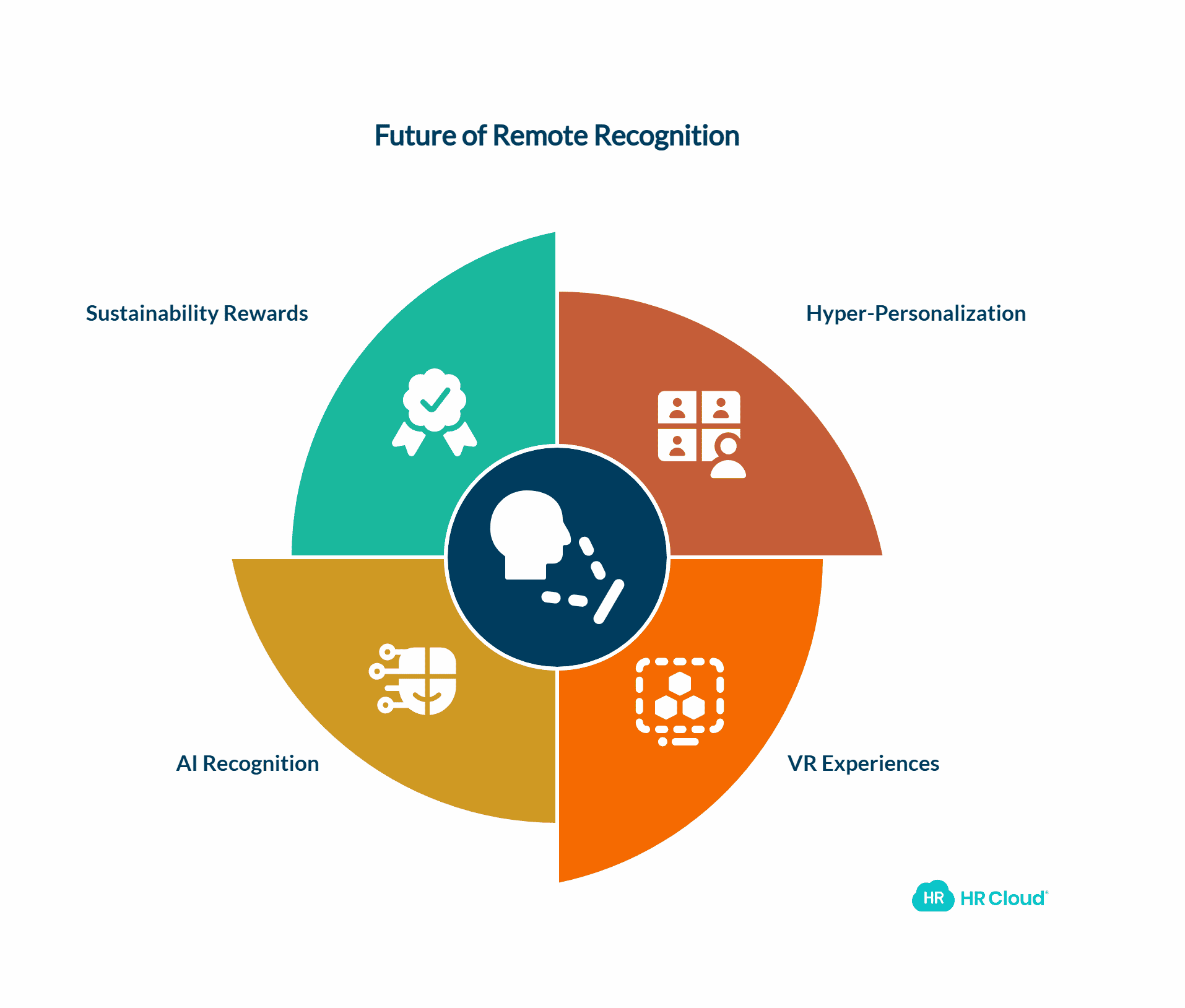
AI-powered recognition intelligence is transforming appreciation from reactive acknowledgment to proactive engagement management. Predictive analytics identify at-risk employees by analyzing recognition patterns, participation rates, and behavioral signals correlating with flight risk. AI-suggested recognition opportunities help managers overcome visibility problems through prompts like "Jamal just completed his fifth consecutive on-time project delivery—consider recognizing his consistency."
VR and metaverse recognition experiences create immersive appreciation overcoming digital distance limitations. Virtual awards ceremonies in metaverse environments replicate emotional power of in-person celebrations, with avatars gathering in virtual auditoriums and walking across digital stages to receive awards.
Hyper-personalization moves recognition away from one-size-fits-all approaches toward individualized experiences. Individual recognition preference profiles allow employees to indicate how they want acknowledgment. Reward recommendations based on interests ensure tangible appreciation resonates personally—hiking gear for outdoor enthusiasts, educational platforms for continuous learners.
Sustainability-focused rewards reshape preferences, especially among younger employees prioritizing purpose. Carbon-credit rewards, green subscriptions, and charitable giving options connect recognition to social and environmental impact. Digital-first alternatives to physical rewards reduce environmental footprint while maintaining appreciation value.
Conclusion: Recognition as Competitive Advantage
Remote work permanently changed how organizations operate. Companies thriving in this environment recognize that traditional management approaches don't automatically translate to distributed workforces. Recognition is one of the most critical adaptations required—and most powerful competitive advantages when done well.
The data is unequivocal. Companies with strong recognition programs achieve 21% higher profits and 18% lower turnover, creating workplaces where employees are 9x more likely to feel belonging when recognized weekly. These aren't marginal improvements—they're transformational results separating industry leaders from struggling competitors.
Yet 82% of remote workers still feel unrecognized, creating a massive opportunity for organizations willing to invest in systematic appreciation cultures. The talent scarcity characterizing 2025 makes retention more critical than ever. Recognition isn't a nice-to-have perk—it's essential infrastructure for workforce stability.
The seven pillars outlined in this playbook provide a framework for building recognition programs actually working in remote environments. Organizations executing across all seven dimensions create compounding cultural advantages competitors struggle to replicate.
Implementation doesn't require perfection on day one. Start with the 30-day action plan, build momentum through quick wins, and evolve based on data and feedback. The journey from recognition gaps to thriving appreciation culture takes time, but every step forward yields measurable benefits in engagement, retention, and performance.
The stakes are clear. In talent-constrained markets where employee expectations continue rising and remote work remains standard, recognition separates employers of choice from employers of last resort. Organizations building systematic recognition cultures will win the competition for talent. Those who don't will watch their best people leave for competitors who make them feel valued.
Recognition isn't about feel-good gestures or participation trophies. It's about building systematic appreciation where every employee—regardless of location, time zone, role, or tenure—knows their work matters and their contributions are seen. That's not just good culture. It's good business.
The question isn't whether to invest in remote recognition. It's whether you can afford not to.
Additional Resources
Continue Your Recognition Journey
Explore these related resources to deepen your understanding and expand your employee engagement capabilities:
The Ultimate Guide to Employee Onboarding in Remote Teams – Connect recognition to seamless onboarding experiences that start new hires on the right cultural foot from day one.
Top 10 Benefits of Effective Communication in the Workplace – Understand how recognition integrates with broader communication strategies to drive engagement and productivity.
Building Company Culture: Why Customizability Matters – Learn how tailored solutions support unique organizational cultures better than generic platforms that force one-size-fits-all approaches.
Employee Engagement Platform Comparison Guide – Evaluate comprehensive engagement solutions that unite recognition with communication and culture-building for maximum impact.
Ready to transform your remote employee recognition from ad-hoc acknowledgment to systematic competitive advantage? Schedule your personalized demo to explore how comprehensive employee engagement platforms can help you build the appreciation culture your distributed workforce deserves.
Frequently Asked Questions
How often should remote employees be recognized?
Employees receiving meaningful recognition weekly are 9x more likely to feel strong belonging compared to monthly recognition cycles. Weekly acknowledgment establishes baseline for effective employee appreciation programs, with additional spontaneous recognition for exceptional contributions and milestone achievements. Organizations should aim for balanced mix of daily informal kudos through team channels, weekly team recognition during meetings, monthly formal awards tied to company values, and quarterly milestone celebrations for tenure and major accomplishments.
What's the ROI of recognition programs?
Organizations with strong recognition programs achieve 21% higher profitability and 18% lower turnover compared to companies with weak appreciation cultures and minimal recognition initiatives. Turnover reduction alone typically justifies recognition software costs, as replacing employees costs 50-200% of annual salary when factoring recruiting expenses, training time, productivity loss, and knowledge transfer. Most organizations implementing systematic employee recognition platforms calculate positive return on investment within 12-18 months through improved retention rates, increased productivity, and enhanced employee satisfaction scores.
How do we ensure equitable recognition distribution?
Equity in employee recognition requires intentional system design, ongoing monitoring through analytics, and proactive intervention when gaps emerge. Implement recognition analytics tracking distribution patterns across locations, departments, roles, shifts, and demographic groups to identify disparities before they impact morale. Train managers on proximity bias and establish recognition frequency expectations for all team members regardless of work location. Use employee engagement platforms with built-in equity features like automated recognition reminders, participation tracking dashboards, and milestone acknowledgment ensuring no employee falls through cracks.
What rewards work best globally?
Global teams and international workforces require flexible reward options accommodating diverse cultural preferences, multiple currencies, and universal accessibility across regions. Digital gift cards to major international retailers and e-commerce platforms work well providing employee choice and instant delivery. Charitable donation options allowing employees to support causes they care about resonate across cultures and demonstrate social responsibility. Professional development credits for online courses, certifications, or conference attendance appeal to growth-oriented employees worldwide. Recognition platforms offering 100+ reward options with global accessibility solve diversity challenges through choice architecture rather than imposing one-size-fits-all rewards that may not resonate with all workforce segments.
How do we get managers to use platforms consistently?
Manager adoption of recognition software requires reducing friction through seamless integration, providing ongoing support with templates and prompts, and creating accountability through participation tracking. Select employee recognition platforms integrating seamlessly with tools managers already use daily—Slack, Teams, email integrations eliminate separate login barriers that kill adoption rates. Provide recognition message templates and suggested language so managers don't struggle finding appropriate words for acknowledgment. Train leadership on business impact using concrete data showing correlation between recognition frequency and retention rates. Implement automated prompts alerting managers to recognition opportunities like milestone anniversaries or project completions. Establish accountability by tracking manager recognition activity in leadership dashboards and including appreciation behaviors in management performance evaluations.
Can peer recognition work without favoritism?
Peer-to-peer recognition succeeds when properly structured with clear guidelines, values alignment, and appropriate oversight preventing popularity contests. Tie recognition criteria to specific company values and observable behaviors rather than vague popularity metrics, requiring nominators to explain how colleagues demonstrated particular values through concrete actions. Establish recognition standards emphasizing measurable contributions, helpfulness to team members, collaboration quality, and values demonstration rather than personal relationships. Use analytics software to monitor peer recognition patterns and identify potential favoritism or clique formation. Research shows peer-to-peer recognition drives 35.7% better financial results than manager-only approaches when implemented with appropriate structure, guidelines, and monitoring systems.
Should recognition replace compensation?
Employee recognition should supplement competitive compensation and performance bonuses, never replace fair pay and benefits packages. Employees rightfully expect market-rate base pay reflecting skills, experience, and performance plus bonuses tied to individual and organizational results. Recognition serves complementary purpose—providing frequent psychological reinforcement, social appreciation, and cultural connection that monetary compensation alone cannot deliver. Research shows 69% would work harder if better appreciated, but appreciation programs don't mean accepting below-market pay or inadequate benefits. Effective total rewards strategies combine competitive compensation with frequent recognition, modest tangible rewards for ongoing contributions, and substantial performance bonuses for exceptional results.
What if our budget is extremely limited?
Effective employee recognition doesn't require large budgets—consistency, authenticity, and timeliness matter more than expensive rewards or elaborate programs. Start with zero-cost recognition strategies through public acknowledgment in team meetings, communication channels, and company announcements emphasizing specific behaviors and impacts. Create monthly awards using digital badges or certificates requiring no monetary investment. Implement peer nomination processes where colleagues recognize each other through written appreciation and social recognition. When budget allows modest spending, consider small digital gift cards in $5-25 amounts for spontaneous appreciation moments. Even basic recognition platforms often provide affordable pricing for small businesses enabling systematic tracking, automated reminders, and basic analytics without major upfront investment.
How do we measure if programs are working?
Track multiple performance dimensions over time using combination of quantitative metrics and qualitative feedback. Monitor participation statistics including percentage of employees giving and receiving recognition, average recognition frequency per employee, and distribution across departments and locations. Survey employees quarterly about feeling valued, appreciated, and recognized for contributions using pulse surveys and employee satisfaction assessments. Track retention metrics comparing employees receiving regular recognition versus those receiving little acknowledgment. Analyze correlation between recognition patterns and performance ratings, productivity metrics, and business outcomes. Use analytics dashboards tracking key metrics over time to identify positive trends, spot emerging equity gaps, and measure progress toward stated goals for recognition program effectiveness.
Can small companies under 50 employees benefit?
Employee recognition programs work exceptionally well for small companies and growing businesses where cultural foundations are being established and every team member's contributions significantly impact organizational success. Small organizations have inherent advantages in recognition initiatives—closer personal relationships enabling authentic appreciation, less bureaucracy allowing faster program implementation, and more direct impact visibility making recognition easier to tie to concrete business outcomes. For small businesses, platforms combining recognition with other HR management needs provide best value by solving multiple challenges through integrated human resource systems. Focus on genuine, frequent, personal appreciation leveraging tight-knit relationships and direct impact visibility that small organizations naturally possess as competitive advantages.

Keep Reading
Why Workmates by HR Cloud Stands Out: Best Recognition Tool to Drive Employee Motivation
Workmates by HR Cloud delivers comprehensive peer-to-peer recognition through
Giant List of 100+ Employee Recognition Message Templates (Just Copy & Paste)
"Great job!" is the workplace equivalent of "We need to talk" — vague and unhelpful. And
Best Peer-to-Peer Recognition Software & Kudos Platforms (2025 Buyer's Guide)
Picture this: A manufacturing team in Ohio just hit their monthly safety record. In the
Like What You Hear?
We'd love to chat with you more about how HR Cloud® can support your business's HR needs. Book Your Free Demo

Build a Culture of Recognition. Boost Engagement. Guaranteed.
Workmates empowers employees to stay informed, connected, and appreciated—whether they’re on the front line, in the office, or remote. Recognition drives 12x higher engagement.Trusted by industry leaders in every sector




Cut Onboarding Costs by 60%.
Take the confusion and follow-ups out of onboarding with automated workflows, digital forms, and structured portals—so new hires ramp faster 3X quicker.Trusted by industry leaders in every sector




